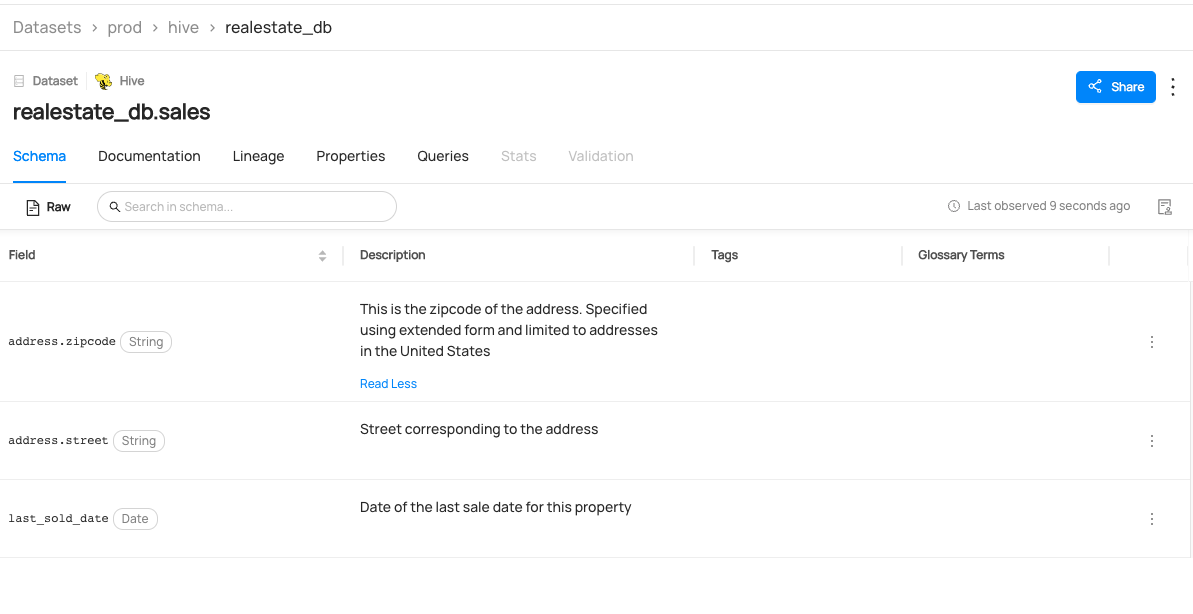Creating Datasets
Why Would You Create Datasets?
The dataset entity is one the most important entities in the metadata model. They represent collections of data that are typically represented as Tables or Views in a database (e.g. BigQuery, Snowflake, Redshift etc.), Streams in a stream-processing environment (Kafka, Pulsar etc.), bundles of data found as Files or Folders in data lake systems (S3, ADLS, etc.). For more information about datasets, refer to Dataset.
Goal Of This Guide
This guide will show you how to create a dataset named realestate_db.sales with three columns.
Prerequisites
For this tutorial, you need to deploy DataHub Quickstart and ingest sample data. For detailed steps, please refer to Prepare Local DataHub Environment.
Create Datasets With GraphQL (Not Supported)
🚫 Creating a dataset via GraphQL is currently not supported. Please check out API feature comparison table for more information,
Create Datasets With Python SDK
The following code creates a hive dataset named realestate_db.sales with three fields.
You can refer to the complete code in dataset_schema.py.
# inlined from metadata-ingestion/examples/library/dataset_schema.py
# Imports for urn construction utility methods
from datahub.emitter.mce_builder import make_data_platform_urn, make_dataset_urn
from datahub.emitter.mcp import MetadataChangeProposalWrapper
from datahub.emitter.rest_emitter import DatahubRestEmitter
# Imports for metadata model classes
from datahub.metadata.schema_classes import (
AuditStampClass,
DateTypeClass,
OtherSchemaClass,
SchemaFieldClass,
SchemaFieldDataTypeClass,
SchemaMetadataClass,
StringTypeClass,
)
event: MetadataChangeProposalWrapper = MetadataChangeProposalWrapper(
entityUrn=make_dataset_urn(platform="hive", name="realestate_db.sales", env="PROD"),
aspect=SchemaMetadataClass(
schemaName="customer", # not used
platform=make_data_platform_urn("hive"), # important <- platform must be an urn
version=0, # when the source system has a notion of versioning of schemas, insert this in, otherwise leave as 0
hash="", # when the source system has a notion of unique schemas identified via hash, include a hash, else leave it as empty string
platformSchema=OtherSchemaClass(rawSchema="__insert raw schema here__"),
lastModified=AuditStampClass(
time=1640692800000, actor="urn:li:corpuser:ingestion"
),
fields=[
SchemaFieldClass(
fieldPath="address.zipcode",
type=SchemaFieldDataTypeClass(type=StringTypeClass()),
nativeDataType="VARCHAR(50)", # use this to provide the type of the field in the source system's vernacular
description="This is the zipcode of the address. Specified using extended form and limited to addresses in the United States",
lastModified=AuditStampClass(
time=1640692800000, actor="urn:li:corpuser:ingestion"
),
),
SchemaFieldClass(
fieldPath="address.street",
type=SchemaFieldDataTypeClass(type=StringTypeClass()),
nativeDataType="VARCHAR(100)",
description="Street corresponding to the address",
lastModified=AuditStampClass(
time=1640692800000, actor="urn:li:corpuser:ingestion"
),
),
SchemaFieldClass(
fieldPath="last_sold_date",
type=SchemaFieldDataTypeClass(type=DateTypeClass()),
nativeDataType="Date",
description="Date of the last sale date for this property",
created=AuditStampClass(
time=1640692800000, actor="urn:li:corpuser:ingestion"
),
lastModified=AuditStampClass(
time=1640692800000, actor="urn:li:corpuser:ingestion"
),
),
],
),
)
# Create rest emitter
rest_emitter = DatahubRestEmitter(gms_server="http://localhost:8080")
rest_emitter.emit(event)
We're using the MetdataChangeProposalWrapper to change entities in this example.
For more information about the MetadataChangeProposal, please refer to MetadataChangeProposal & MetadataChangeLog Events
Expected Outcomes
You can now see realestate_db.sales dataset has been created.

What's Next?
Now that you created a dataset, how about enriching it? Here are some guides that you can check out.
